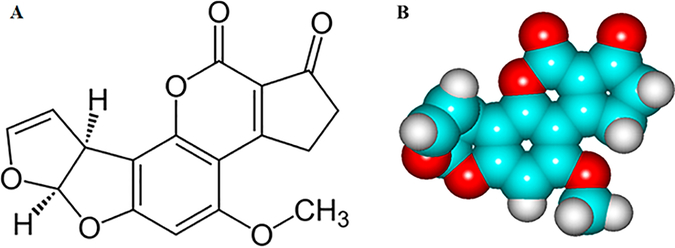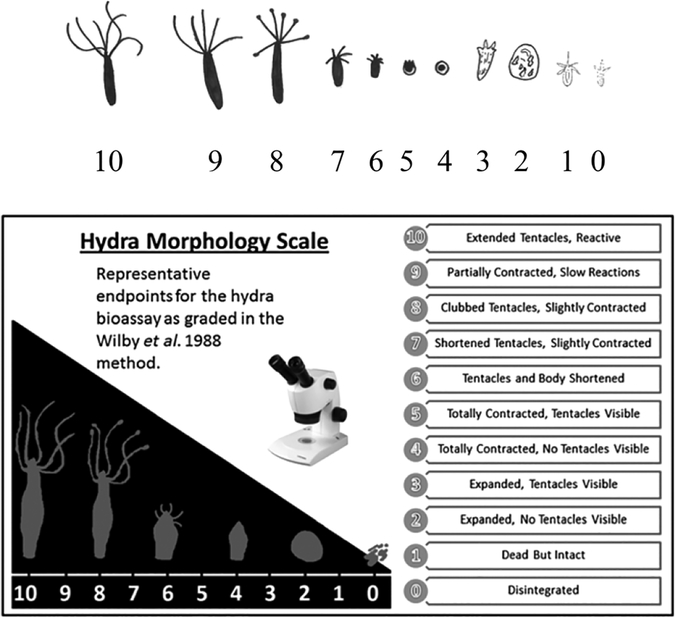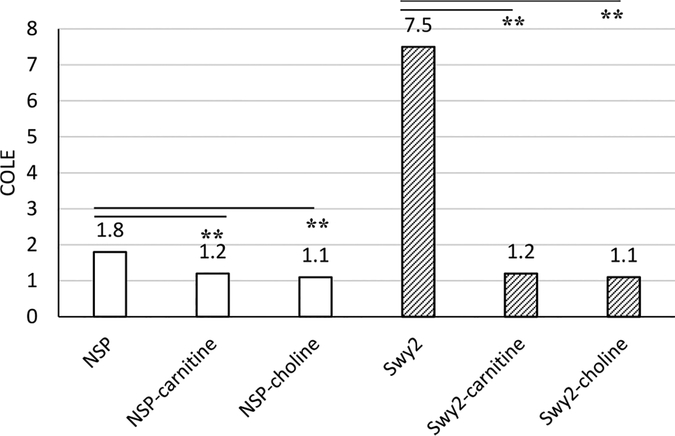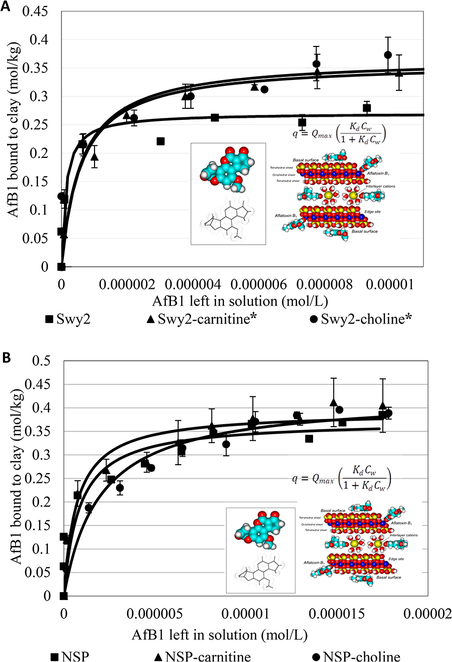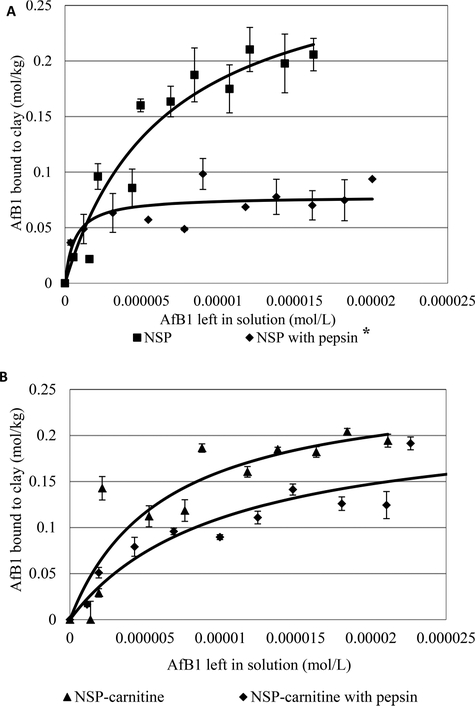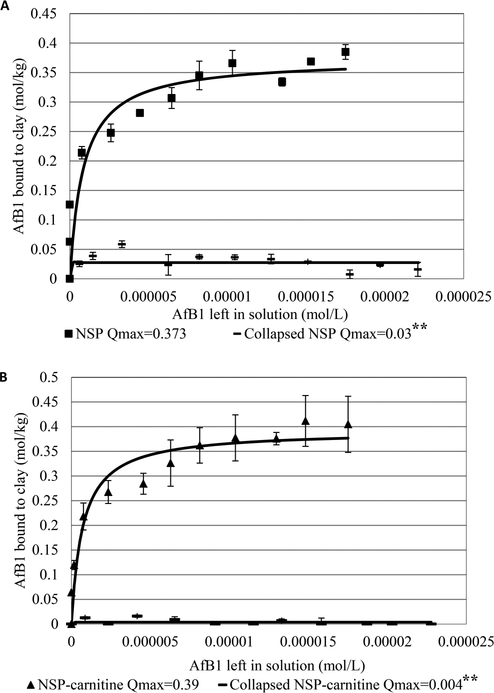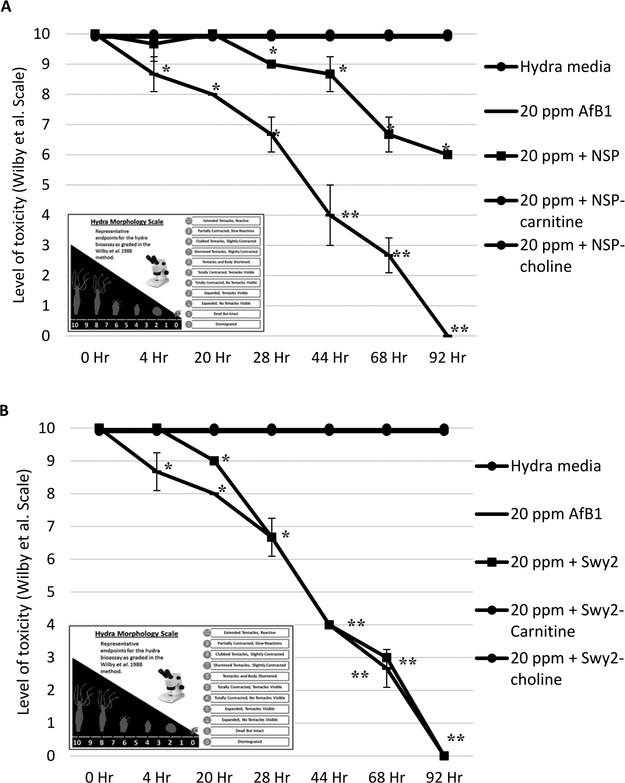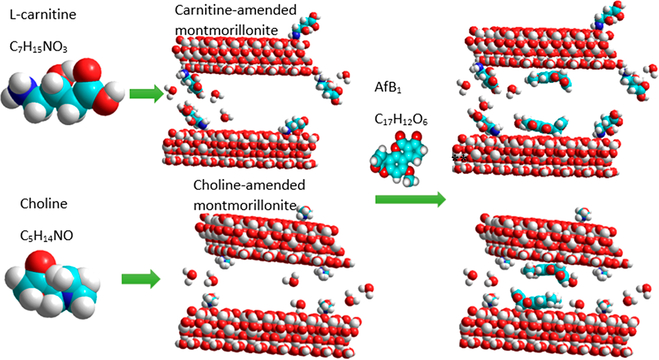Abstract
Previously, a calcium montmorillonite clay (NovaSil) included in the diet of animals has been shown to bind aflatoxin B1 (AfB1) and reduce the symptoms of aflatoxicosis. To investigate and improve the capacity and efficacy of clay-based materials as aflatoxin sorbents, we developed and tested calcium and sodium montmorillonite clays amended with nutrients including L-carnitine and choline. Also, we determined the sorption of AfB1 by isothermal analysis and tested the ability of these amended sorbents to protect adult hydra from AfB1 toxicity. The results showed that exchanging montmorillonite clays with L-carnitine and choline inhibited swelling of the clays and increased the sorption capacity and efficacy of clay surfaces for AfB1. Results from dehydroxylated and heat-collapsed clays suggested that AfB1 was primarily adsorbed in the clay interlayer, as predicted from thermodynamic calculations and computational modeling. The hydra bioassay further indicated that the modified clays can significantly protect adult hydra from AfB1 with as low as 0.005% clay inclusion. This enterosorbent therapy may also be applied to screen hazardous chemicals such as pesticides and PAHs based on similar sorption mechanisms. Taken together, enterosorbent therapy could be delivered in nutritional supplements, foods that are vulnerable to aflatoxin contamination, flavored liquids and animal feeds during emergencies and outbreaks of acute aflatoxicosis, and as a screening model for hazardous environmental chemicals.
INTRODUCTION
Aflatoxins are secondary fungal metabolites produced by Aspergillus flavus and Aspergillus parasiticus. They are widespread and cause problems especially during extended periods of heat and drought. Fungal growth in food is favored by over 85% relative humidity and 25 °C.1 Among the 16 naturally occurring aflatoxins, aflatoxin B1 (AfB1) (Figure 1) is the most toxic and is commonly detected in various food and feed products.2 Symptoms caused by AfB1 in animals and humans include growth stunting, weight loss, liver toxicity, immunosuppression, and cancer.3
Figure 1.
Structure of AfB1 (A) and a molecular model (B) illustrating the spatial orientation and size of the functional groups.
Previously, our laboratory has conducted a series of in vitro studies, which have shown that Novasil Plus (NSP), a 2:1 layered calcium montmorillonite, is a unique sorbent that can tightly bind AfB1. Its inclusion into feedstuffs and food has been reported to protect numerous animal species and reduce biomarkers of AfB1 exposure in humans.1,4–7 The mechanism of this protection involves adsorption of AfB1 onto active interlayer surfaces of NSP, resulting in the reduced concentration of unbound toxin in the gastrointestinal tract and decreased bio availability and toxicity of AfB1.8
Sodium montmorillonite (although similar in structure to NSP) is considered a less selective sorbent due to its high expansibility (swelling) in water and its potential for nonspecific binding. This study was aimed to improve clay-based sorbents for AfB1 by modifying a calcium-rich montmorillonite (NSP) and a sodium-rich montmorillonite (Swy2) with L -carnitine and choline. L-Carnitine is an important enzyme cofactor for metabolism including the oxidation and transportation of fatty acids.9 Choline is an essential water-soluble vitamin that is involved in amino acid metabolism.10 Deficiencies in L-carnitine and choline have been reported to be associated with liver disease and cardiac and muscle metabolic diseases.10–12 Since L-carnitine and choline are included in diets as essential nutrients and are considered to be safe, the potential for partial dissociation from clay would not be of concern. At 100% cation exchange capacity, amended sodium montmorillonite clays have been shown to be stable and heat resistant, and able to adsorb certain hydrophobic herbicides (i.e., terbuthylazine and diuron).13 Previous studies by Jaynes and Zartman, using amended low-charge sodium montmorillonite clays, showed increased binding for aflatoxin from aqueous corn flour.14 Also, the treatment of modified clays with organic cations has been applied successfully with water filtration and decontamination,15–18 metal and mineral adsorption,19 color bleaching,20,21 removal of organics,22 etc. The molecular mechanism for this effect apparently involves changing the nature of clay surfaces from hydrophilic to hydrophobic, which attracts organophilic chemicals to the active surfaces.
Although parent NSP serves as one of the most specific and effective AfB1 sorbents, isothermal analysis indicates that it binds 30% of the toxin at a concentration equal to 8 ppm. When included in the diet at 0.25% w/w, it decreases biomarkers of exposure in animals and humans by approximately 30–60%.5,6,23–25 On the basis of earlier work with herbicides, it is postulated that L-carnitine and choline modified montmorillonites may sorb aflatoxins better than parent clays due to their hydrophobicity, thus increasing the binding capacity for toxin in vitro and in vivo. This study was designed to (l) investigate the affinity and capacity of nutrient-amended montmorillonite surfaces for aflatoxins and (2) predict their ability to prevent adverse effects of aflatoxin B1 using the adult hydra assay.
MATERIALS AND METHODS
Reagent.
High pressure liquid chromatography (HPLC) grade methanol, acetonitrile reagents, and pH buffers (4.0, 7.0 and 10.0) were purchased from VWR (Atlanta, GA). AfB1, pepsin, L-carnitine, and choline were purchased form Sigma-Aldrich (Saint Louis, MO). NovaSil was obtained from Engelhard Corp (Cleveland, OH) and was sieved through 45 μm. Swy2 was a gift from the Source Clay Repository at Purdue University. Ultrapure deionized water (18.2 Ω) was generated within the lab using an Elga automated filtration system (Woodridge, IL).
Synthesis of Sorbents.
Parent NSP and Swy2 sorbents were modified with L-carnitine and choline at 100% cation exchange capacity (CEC = 97 cmol kg−1). Calculated amounts of cations and 2 g of parent materials were added in 40 mL of 1 mM HN03. The suspensions were mixed and stirred for 24 h at ambient temperature, then centrifuged at 2000g for 20 min and washed with 100 mL of distilled water. This centrifugation—washing process was repeated three times. All samples were dried in an oven at 110 °C overnight before grinding and passing through a 125 μm sieve.
In order to confirm the importance of an intact interlayer and investigate cation and toxin binding sites, experiments with heat-collapsed sorbents were conducted. Collapsed sorbents were prepared by heating parent and amended sorbents at 200 °C for 30 min and 800 °C for 1 h to collapse the interlayer.2
Coefficient of Linear Expansibility in Water.
Sorbent samples were added to the 2 mL mark in graduated cylinders, then stirred with 15 mL of water. After 24 h following thorough equilibrium hydration and swelling, the final sorbent volume was determined. The ratio calculated from the beginning (2 mL) and final volume is indicative of the hydration and expansion of the sample. A higher ratio indicates greater hydration and expansion of the sample.
In Vitro Isothermal Adsorption.
The AfB1 stock solution was prepared by dissolving pure crystals into acetonitrile. A calculated amount of the stock solution was injected into pH 6.5 of distilled water to yield an 8 ppm (8 μg/mL) AfB1 solution, which was confirmed by scanning and reading the absorption at 362 nm using a UV–visible spectrophotometer. The maximum AfB1 concentration was set as 8 ppm (well below the solubility range of 11–33 ppm) so that precipitation of AfB1 did not occur in the solutions.26 Then, 100 /¿g of sorbents was exposed to an increasing concentration gradient of AfB1 solution: 0.4, 0.8, 1.6, 2.4, 3.2, 4, 4.8, 6, 6.4, 7.2, and 8 ppm. The concentration gradients of AfB1 solutions were achieved by adding a calculated amount of 8 ppm solution along with a complementary volume of distilled water to sterile 17 × 100 mm polypropylene centrifuge tubes to make a total volume of 5 mL. The 100 μg sorbent inclusion was achieved by injecting 50 μL of 2 mg/mL clay suspension, which was mixed vigorously during the transfer to the sorbent/toxin mixture by an autopipetter. Besides testing samples, there were 3 controls consisting of 5 mL of distilled water, 5 mL of 8 ppm AfB1 solution without sorbent, and 5 mL of 100 μg sorbent in distilled water. The control and test groups were capped and agitated at 1000 rpm for 2 h at ambient temperature using an electric shaker. All samples were then centrifuged at 2000gfor 20 min to separate the clay/AfB1 complex from solution. An UV—visible spectrophotometer was used to measure the absorption of AfB1 in the supernatant from samples and controls.
Data Calculations and Curve Fitting.
The UV-visible absorption data were used to calculate the concentration of AfB1 left in solution (c) by Beer’s law (x-axis). The amount adsorbed for each data point (y-axis) was calculated from the concentration difference between test and control groups. More specifically, the y-axis is the amount of toxin bound by sorbents (in mol/kg). It is calculated by the difference in moles of free toxin in the test solution versus control groups and is then divided by the mass of the clays included.
where e is the molar extinction coefficient (e for AfB1 = 21,865 cm−1 mol−1), and L is the path length of the cell holder = 1 cm, dependent on the cuvette.
These data were then plotted using Table-Curve 2D and a computer program that was developed with Microsoft Excel to derive values for the variable parameters. The best fit for the data was a Langmuir model, which was used to plot equilibrium isotherms from triplicate analysis. The isotherm equation was entered as user-defined functions:
where q = AfB1 adsorbed (mol/kg),Qmax = maximum capacity (mol/kg), Kdd = distribution constant, Cw = equilibrium concentration of AfB1.
The plot will normally display a break in the curve. The value on the x axis where the curve breaks is an estimate of Kd1−. The value on they axis where the curve breaks is an estimate of Qmax The Qmax is taken from the fit of LM to the adsorption data.
The definition of Kd is derived by solving for Kd from the Langmuir equation giving
AfB1 Adsorption in a Simulated Stomach Model.
The gastrointestinal model previously reported was slightly modified to focus on the stomach in these studies.27–29 On the basis of this model, an aqueous solution (pH 2) with 2 mg/mL pepsin was prepared in a water-jacketed beaker and maintained at 37 °C. The concentration gradients of AfB1 solutions were achieved by adding a calculated amount of 8 ppm solution along with the aqueous pepsin solution. Then, 100 μg of sorbents was exposed to an increasing gradient of AfB1 solution. The samples were capped and agitated at 1000 rpm for 2 h at 37 °C. Samples were centrifuged at 2000gfor 20 min to separate the clay/AfB1 complex. The absorption of AfB1 was measured with a UV–visible spectrophotometer, and the adsorption isotherms were plotted as described above.
Hydra Assay.
Hydra vulgaris were obtained from Environment Canada (Montreal, Qc) and maintained at 18 °C. The hydra classification method30 was used with modification to rate morphology of the adult hydra as an indicator of solution toxicity. The illustration of this classification is indicated in Figure 2. In this assay, the scoring of hydra morphology is objective and repeatable as indicated in previous literature. The assay included monitoring times at shorter intervals during the first 2 days (0,4, 20, and 28 h) and 24 h intervals for the last 3 days (44, 68, and 92 h). Solutions were not changed during testing. The Hydra morphological response was scored and recorded after exposure to AfB1 with and without sorbent treatment. Mature and nonbudding hydra in similar sizes were chosen for testing in order to minimize differences between samples. Controls for this experiment included hydra media consisting of 18.2 Ω2 water, 4 mg/L EDTA, 115 mg/L N-tris[hydroxymethyl] methyl-2- aminoethanesulfonic acid (TES), and 147 mg/L CaCl2 adjusted to pH 6.9—7.0. Sorbent inclusion percentage was chosen based on previous studies.31,32 Toxin treatment groups included 20 ppm AfB1 in hydra media based on the minimum effective dose (MEC). MEC is the lowest dose that caused 100% mortality in 92 h. All test solutions were capped and prepared by shaking at 1000 rpm for 2 h and centrifugation at 2000g for 20 min prior to toxin exposure of hydra in the Pyrex dishes.33 For each sample, 3 hydra were included into 4 mL of test media and kept at 18 °C. The score or average toxicity rating was determined by calculating the average score for morphological changes for a certain group at a specific time point.
Figure 2.
Hydra morphology scale by the Wilby method, 1988.27 The scale is graded from 0 to 10, where 10 represents a normal living hydra, and 0 represents a disintegrated hydra. The physiologic conditions of hydra were assessed with a dissecting microscope.
Molecular Models.
The molecular model for montmorillonite was drawn in ISIS Draw 2.0 and then imported into HyperChem 8.0. The aflatoxin, carnitine, and choline structures were energy-minimized using the semiempirical quantum mechanical AMI method. The model was constructed using the unit cell coordinates of muscovite.34 These coordinates were then converted to orthogonal coordinates in an Excel spreadsheet that was constructed from a public domain C program. The unit cells were replicated in three-dimensional space by applying the symmetry operations for a C2/c space group.35 The d00l spacing of the model was then set to the corresponding dimensions of the exchanged montmorillonite (21 Å) based on the report of Greenland and Quirk.36 Aflatoxin, carnitine, and choline were inserted into the interlayer and on the external surface37 to illustrate the proposed sites of aflatoxin adsorption.1,2
Statistical Analysis.
A one way t test was used to calculate statistical significance. Each experiment was independently triplicated to derive an average and standard deviation. In the t test, the average COLE ratio from COLE experiments, Qmax from equilibrium isothermal analyses, and toxicity scores from the hydra assay were included to calculate D = control-test groups and D2. Then, the t-value was calculated using the following equation (N = 3):
The t-value and DF (degrees of freedom) were compared in a p-value table to determine the statistical significance. Results were considered significant at P ≤ 0.05.
RESULTS
Coefficient of Linear Expansibility in Water.
The COLE ratio indicates the expansibility of sorbents in water. COLE = expansion volume of clay/original volume of clay. The higher the ratio, the more expansion and hydration of the sample. The accuracy of this experiment was confirmed by the COLE values of NSP and Swy2 clays, which predicted calcium-rich and sodium-rich montmorillonite, respectively. The COLE ratios for exchanged clays with L-carnitine and choline values were 1.1 and 1.2, showing very limited swelling compared to their parent sorbents as shown in Figure 3.
Figure 3.
Coefficient of linear expansibility for sorbents in water. The COLE value for Swy2 indicated significant hydration and expansibility, whereas COLE values for other sorbents displayed very limited hydration energy and expansibility. Statistical significance is denoted by *(P < 0.05) and **(P < 0.01).
Isothermal Adsorption and Analyses for AfB1.
Equilibrium isotherms were generated by Table-Curve 2D and a computer program developed in our laboratory using Microsoft Excel. This program was used to derive affinities (Kd), capacities (Qmax in mol AfB1 bound kg −1 sorbent), and the enthalpy of sorption for toxin–surface interactions. On the basis of r2 values and randomness of the residuals, the best fit for the data was a Langmuir model, which was used to plot equilibrium isotherms from triplicate analyses. Each point represents the values calculated for AfB1 bound to clay (mol/kg) and AfB1 left in solution (mol/L) for the corresponding 11 dilutions. Isotherms were performed at ambient temperature and light.
Figure 4 shows the AfB1 isothermal plot on Swy2 and NSP modified clays. For all isotherms, the r2 values (or coefficients of determination) were above 0.8, indicating that the raw data strongly fit the Langmuir model and that AfB1 binds tightly onto clay surfaces and does not dissociate easily. The derived for Swy2-carnintine and Swy2-choline are significantly increased from that of parent Swy2 sorbent. The Langmuir plots on NSP-modified clays also indicates an increase in binding capacity for aflatoxin. Carnitine and choline improved the binding of aflatoxin by NSP and Swy2, although the effect was slightly better for Swy2. The Kd values for parent and amended clays were similar. In another isothermal plot simulating the stomach model with the addition of pepsin at pH 2, the AfB1 adsorption on NSP and NSP-carnitine both decreased dramatically compared to the Qmax derived from the control treatment. Interestingly, adsorption of AfB1 decreased by 73% on parent NSP (Qmax = 0.08), whereas adsorption only decreased by 21% on NSP-carnitine (Qmax = 0.26) as shown in Figure 5. After the interlayers were collapsed from heating at 800 °C, AfB1 adsorption was dramatically decreased (Figure 6). Collapsed NSP and NSP-carnitine both decreased in their capacity to bind aflatoxin with values Qmax equal to 0.03 and 0.004, respectively.
Figure 4.
Langmuir plots of AfB1 on Swy2 (A) and NSP (B) showing the observed and predicted Qmax values at pH 6.5. The Qmax values indicated tight binding for all three sorbents. Swy2, Qmax = 0.27; Kd = 7E6. Swy2-carnitine: Qmax = 0.36; Kd = 2E6. Swy2-choline: Qmax = 0.367; Kd = 2E6. AfB1 left in solution (mol/L) NSP: Qmax= 0.37; Kd = 1E6. NSP-carnitine: Qmax = 0.39; Kd = 1.4E6. NSP-choline: Qmax = 0.42; Kd = 5E5.
Figure 5.
Langmuir plots of AfB1 in a simulated stomach model of NSP (A) and NSP-carnitine (B) at pH 2. The Qmax values indicated tight binding for NSP and NSP-carnitine sorbents in the stomach model. NSP: Qmax = 0.3; Kd = 1E5. NSP-carnitine: Qmax = 0.26; Kd = 1E5. NSP with pepsin: Qmax = 0.08; Kd = 1.5E6. NSP-carnitine with pepsin: Qmax = 0.22; Kd = 1E5.
Figure 6.
Langmuir plots of AfB1 on collapsed NSP (A) and collapsed NSP-carnitine (B) at pH 6.5. The Qmax values for NSP and NSP-carnitine indicated tight binding, whereas the Qmax values for collapsed NSP and collapsed NSP-carnitine indicated very limited binding.
Hydra Assay
The minimal effective concentration (MEC) for AfB1 has been established earlier at 20 ppm, which results in 100% hydra mortality in 92 h. Amended sorbents at very low inclusion rates of 0.005% rendered a significant protection for hydra against AfB1, resulting in morphologic ratings not different from the hydra media control group, whereas at the same inclusion levels for unmodified NSP and especially Swy2, the scores are similar to the AfB1 control group, showing no protection derived from these parent sorbents at 0.005% (Figure 7). On the basis of the isothermal and hydra results above, the estimated molecular models for aflatoxin, L-carnitine, and choline on surfaces of montmorillonites are shown in Figure 8.
Figure 7.
Hydra toxicity and protection by parent and amended NSP (A) and Swy2 (B) at 0.005% inclusion. All four amended sorbents were able to protect the hydra at all time points from the toxic effects of AfB1. Hydra media and toxin controls were included in each figure for comparison.
Figure 8.
Computational model of AfB1 binding onto the surfaces of carnitine and choline amended montmorillonites.
DISCUSSION
On the basis of our previous in vitro and in vivo studies, calcium montmorillonite was the most effective aflatoxin enterosorbent. The interlayers of sodium-rich montmorillonite clays are more accessible than calcium montmorillonite, but less selective due to their expansibility in water.
Swy2 is a sodium montmorillonite with high expansibility as indicated by its COLE ratio of 7.5. A modified Swy2 sorbent displayed a larger decrease in expansibility in water, compared to that of NSP. This is probably due to cation exchange and decreased hydration energy in the amended sorbents with carnitine and choline. The smaller sodium ion is more readily hydrated and dissociated than the divalent calcium ion in NSP, explaining the difference in swelling activity between the 2 clays. This restriction of expansibility in water and stabilization of clays by L-carnitine and choline may serve to make these amended clays more effective as toxin enterosorbents by limiting the access of other potentially competing chemicals (such as pepsin) into interlayer channels. For example, calcium montmorillonite has been reported to sorb aflatoxins and fumonisins preferentially with very little interaction with nutrients,5,6 whereas sodium montmorillonite (with higher expansibility) has been shown to bind a wider variety of toxins and nutrients such as xanthophylls.38
NSP (calcium-rich montmorillonite) and Swy2 (sodium-rich montmorillonite) amended with L-carnitine and choline can change the mineral surface polarity and water occupation in the interlayer, and facilitate the incorporation of aflatoxin molecules in the interlayer of the montmorillonite. As AfB1 is only slightly soluble in water based on its high Kow (octanol/water partition coefficient) with an estimated solubility range of 11–33 ppm,26 this change in polarity facilitates the sorption of aflatoxins to amended clay surfaces. For example, amendment of Swy2 with choline and L-carnitine resulted in a higher capacity for aflatoxin sorption versus the parent Swy2. A higher capacity was also observed with amended NSP.
Although the expansibility of Swy2 in water is larger than NSP, its binding capacity was typically lower, as shown in Figure 4. Isothermal analysis indicated that sodium montmorillonite amended with L-carnitine and choline markedly increased the binding capacity for aflatoxin. In fact, Swy2-carnitine and Swy2-choline showed the potential to be applied as efficient AfB1 sorbents comparable to NSP since the of amended Swy2 and NSP are similar. The fact that Kd’ s are similar in parent and amended Swy2 indicates that the binding affinity is not affected by the addition of modifiers. It is possible that L-carnitine and choline replaced hydrated inorganic cations (mainly sodium and calcium) and balanced platelet surface charge, exposing hydro-phobic surfaces that favor AfB1 adsorption. This modification by L-carnitine and choline provides a novel approach to stabilize swelling sorbents like Swy2 and increase the AfB1 binding capacity similar to NSP.
In Figure 4, NSP amended with L-carnitine and choline both improved aflatoxin binding based on a slightly higher binding capacity compared to that of the parent NSP. In comparison with isothermal results, amending with organic nutrients does not improve the binding efficiency of NSP as much as Swy2, suggesting that L-carnitine and choline work best with swelling sorbents. However, both NSP and Swy2 amended with l-carnitine and choline were able to increase their binding capacity and the percentage of bound AfB1 versus the parent sorbents. Importantly, the increase in binding capacity of NSP predicts its effectiveness in vivo (based on the hydra assay).
Pepsin as one of the major enzymes in the stomach was included in the 11 treatment dilutions at pH 2 to simulate a stomach model. Adsorption results in Figure 5 suggest that with pepsin at pH 2, aflatoxin binding by both parent and amended sorbents decreased due to competition at similar sites. The fact that AfB1 decreased more with parent NSP than with NSP-carnitine indicates that L-carnitine amended clay favors AfB1 binding by blocking the sequestration of pepsin30 and possibly other large proteins and will be more effective as an aflatoxin enterosorbent when included in animal feeds.
After heating at 800 °C, the interlayers of NSP and NSP-carnitine were dehydroxylated and collapsed. Figure 6 shows that binding capacities of collapsed NSP and collapsed NSP-carnitine are significantly reduced. This dramatic decrease of AfB1 suggests (indirectly) that most of the AfB1 binds within the interlayer of these clays and that only minor amounts bind on the edges and basal surfaces. Since the binding capacity of collapsed NSP-carnitine is less than that of collapsed NSP, this indicates that L-carnitine is also bound on sites that were not bound by AfB1. On the basis of isothermal results from heat-collapsed sorbents, we suspect that the addition of L-carnitine and choline (at acidic pH) neutralize interlayer surface charges, occupy polar sites, and create hydrophobic surfaces. More specifically, the interlayer surfaces of parent montmorillonite clays are negatively charged, which can be neutralized by the positive charges from the organic modifiers. This results in a reduction of polar charge which produces more hydrophobic surfaces that facilitate the binding of aflatoxin.
The protective roles of parent and amended clays were identified using the adult hydra assay. As indicated in the results, amended clays at a rate of inclusion as low as 0.005% resulted in significant protection of hydra against AfB1, whereas at the same inclusion levels for unmodified NSP and Swy2, no protection was shown. Both the hydra assay and isotherm binding capacities derived for NSP and Swy2 indicated that parent NSP had better binding of aflatoxin and more protection of hydra than Swy2. Because this work was designed to improve the binding capabilities of clay-based sorbents, we only included low levels of clays (0.005%) in the hydra assay, which was considerably less than the common inclusion level in animal feed (0.2%). As a result, our modified clays increased the binding capacity for aflatoxin and improved the protection of hydra. Unprocessed NSP clay has been shown to be an effective aflatoxin sorbent but only at higher inclusion levels.
In summary, sorbent amendment with L-carnitine and choline results in effective protection of adult hydra against AfB1. This finding in vivo is also consistent with our in vitro isothermal results. The molecular models of modified montmorillonite clays amended with L-carnitine, and choline are shown in Figure 8. With the permanent positive charge from the quaternary ammonium cation, both L-carnitine and choline can bind strongly to the negative surfaces of interlayers and at edge sites of montmorillonite clays.
Taken together, modifying NSP and Swy2 with carnitine and choline reduced the swelling of montmorillonites in water and increased their binding capacity and efficacy for aflatoxins. The increased binding from isothermal analyses (in vitro) was consistent with in vivo protection of adult hydra against AfB1, suggesting that clay minerals (especially swelling montmorillonites) modified with L-carnitine and choline may be effective as enterosorbent therapy for aflatoxins. Our work significantly broadens the mycotoxin binding application of modified clays from a variety of previous studies.13‘14 Janes and Zartman amended sodium montmorillonite instead of calcium montmorillonite; and their results indicated that the amendment of low charge montmorillonite improved aflatoxin binding from contaminated corn flour solutions. Even in this complex matrix, amended montmorillonite clay was able to extract and bind aflatoxin. Our study extended this work using calcium and sodium clays with isothermal analyses in simulated stomach conditions, computational chemistry to delineate potential mechanisms, and protection from aflatoxin in a living organism. Both of these studies support the conclusion that nutrient modifiers improve aflatoxin binding under different conditions. Further studies are warranted to determine the potential for dissociation of the modifiers (nutrients) and their potential interactions in GI tract as well as their safety and efficacy in animals and humans. On the basis of previous findings, we also postulate that these amended clays can be applied to environmental chemicals such as pesticides and PAHs with similar hydrophobicity. The screening of environmental chemicals is ongoing in our laboratory. Our ultimate goal is to develop broad-acting enterosorbents, which can be used to mitigate exposures to mixtures of hazardous toxins in food and feed following outbreaks, natural disasters, spills, and emergencies.
In summary, toxin enterosorbent therapy could be delivered in nutritional supplements, foods that are vulnerable to aflatoxin contamination, flavored liquids, and animal feeds during emergencies and outbreaks of acute aflatoxicosis.
Funding
This work was supported by funding through the National Corn Growers Association (Aflatoxin Mitigation Center of Excellence Research Program M1403049), NIEHS (Superfund Hazardous Substance Research and Training Program), and Omega Biotech, Inc. 500181–62150.
ABBREVIATIONS
- AfB1
aflatoxin Bl
- HPLC
high performance liquid chromatography
- NSP
NovaSil Plus
- GI
gastrointestinal
- CEC
cation exchange capacity
- TES
tris[hydroxymethyl]methyl-2- aminoethanesulfonic acid
- COLE
coefficient of linear expansibility
Footnotes
The authors declare no competing financial interest.
REFERENCES
- (1).Phillips TD, Sarr AB, and Grant PG (1995) Selective chemisorption and detoxification of aflatoxins by phyllo silicate clay. Nat. Toxins 3, 204–213; discussion 221. DOI: 10.1002/nt.2620030407 [DOI] [PubMed] [Google Scholar]
- (2).Grant PG, and Phillips TD (1998) Isothermal Adsorption of Aflatoxin B(1) on HSCAS Clay. J. Agric. Food Chem. 46, 599–605. [DOI] [PubMed] [Google Scholar]
- (3).Murugesan GR, Ledoitx DR, Naehrer K, Bertbiller F, Applegate TJ, Grenier B, Phillips TD, and Schatzmayr G (2015) Prevalence and effects of mycotoxins on poultry health and performance, and recent development in mycotoxin counteracting strategies. Poult. Sci 94, 1298–1315. [DOI] [PMC free article] [PubMed] [Google Scholar]
- (4).Awuor AO, Yard E, Daniel JH, Martín C, Bií C, Romoser A, Oyugi E, Elmore S, Amwayi S, Vulule J, Zitomer NC, Rybak ME, Phillips TD, Montgomery JM, and Lewis LS (2017) Evaluation of the efficacy, acceptability and palatability of calcium montmorillonite clay used to reduce aflatoxin B1 dietary exposure in a crossover study in Kenya. Food Addit. Contain., Part A 34, 93–102. [DOI] [PMC free article] [PubMed] [Google Scholar]
- (5).Maid CR, Thomas AD, Elmore SE, Romoser AA, Harvey RB, Ramirez-Ramirez HA, and Phillips TD (2016) Effects of calcium montmorillonite clay and aflatoxin exposure on dry matter intake, milk production, and milk composition. J. Dairy Sci. 99, 1039–1046. [DOI] [PubMed] [Google Scholar]
- (6).Mitchell NJ, Xue K, Lin S, Marroquin-Cardona A, Brown KA, Elmore SE, Tang L, Romoser A, Gelderblom WC, Wang JS, and Phillips TD (2014) Calcium montmorillonite clay reduces AEB1 and EB1 biomarkers in rats exposed to single and co-exposures of aflatoxin and fumonisin. j. Appl. Toxicol 34, 795–804. [DOI] [PMC free article] [PubMed] [Google Scholar]
- (7).Pollock BH, Elmore S, Romoser A, Tang L, Kang MS, Xue K, Rodriguez M, Dierschke NA, Hayes HG, Hansen HA, Guerra E, Wang JS, and Phillips T (2016) Intervention trial with calcium montmorillonite clay in a south Texas population exposed to aflatoxin. Food Addit. Contam.j Part A 33, 1346–1354. [DOI] [PMC free article] [PubMed] [Google Scholar]
- (8).Phillips TD (1999) Dietary day in the chemoprevention of aflatoxin-induced disease. Toxicol Sci. 52, 118–126. [DOI] [PubMed] [Google Scholar]
- (9).Chen Y, Abbate M, Tang L, Cai G, Gong Z, Wei R, Zhou J, and Chen X (2014) L-Carnitine supplementation for adults with end-stage kidney disease requiring maintenance hemodialysis: a systematic review and meta-analysis. Am. J. Clin. Nutr 99, 408–422. [DOI] [PubMed] [Google Scholar]
- (10).Rajaie S, and Esmaillzadeh A (2011) Dietary choline and betaine intakes and risk of cardiovascular diseases: review of epidemiological evidence. ARYA Atheroscler. 7, 78–86. [PMC free article] [PubMed] [Google Scholar]
- (11).Bonner CM, DeBrie KL, Hug G, Landrigan E, and Taylor BJ (1995) Effects of parenteral L-carnitine supplementation on fat metabolism and nutrition in premature neonates. J. Pediatr 126, 287–292. [DOI] [PubMed] [Google Scholar]
- (12).Yonei Y, Takahashi Y, Hibino S, Watanabe M, and Yoshioka T (2008) Effects on the Human Body of a Dietary Supplement Containing L-Carnitine and Garcinia cambogia Extract: A Study using Double-blind Tests. J. Clin. Biochem. Nutr 42, 89–103. [DOI] [PMC free article] [PubMed] [Google Scholar]
- (13).Cehs R, Trigo C, Eacenda G, Hermosin Mdel C, and Cornejo J (2007) Selective modification of clay minerals for the adsorption of herbicides widely used in olive groves. J. Agric. Food Chem. 55, 6650–6658. [DOI] [PubMed] [Google Scholar]
- (14).Jaynes WE, and Zartman RE (2011) Aflatoxin toxicity reduction in feed by enhanced binding to surface-modified clay additives. Toxins 3, 551–565. [DOI] [PMC free article] [PubMed] [Google Scholar]
- (15).Wiles MC, Huebner HJ, McDonald TJ, Donnelly KC, and Phillips TD (2005) Matrix-immobilized organoclay for the sorption of polycyclic aromatic hydrocarbons and pentachlorophenol from groundwater. Chemosphere 59, 1455–1464. [DOI] [PubMed] [Google Scholar]
- (16).Alther GR (1995) orgnically modiffied clay removes oil from water. Waste Manage. 15, 623–628. [Google Scholar]
- (17).Mortland MM, Sun S, and Boyd SM (1986) Clay-organic Complexes as Adsorbents for Phenol and Chlorophenols. Clays Clay Miner. 34, 581–585. [Google Scholar]
- (18).Boyd SA, Mortland MM, and Chiou CT (1988) Sorption Characteristics of Organic Compounds on hexadecyltrimethylammo-nium-Smectite. Soil Science Society of America 52, 652–657. [Google Scholar]
- (19).Dias Eilho NL, and do Carmo DR (2006) Study of an organically modified clay: selective adsorption of heavy metal ions and voltammetric determination of mercury(ll). Talanta 68, 919–927. [DOI] [PubMed] [Google Scholar]
- (20).Liu P, and Zhang L (2007) Adsorption of dyes from aqueous solutions or suspensions with day nano-adsorbents. Sep. Purif. Technol 58, 32–39. [Google Scholar]
- (21).Gunawan NS, Indraswati N, Ju Y-H, Soetaredjo EE, Ayucitra A, and Ismadji S (2010) Bentonites modified with anionic and cationic surfactants for bleaching of crude palm oil. Appl Clay Sci. 47, 462–464. [Google Scholar]
- (22).Gitipour S, Huffi W, Bodocsi A, et al. (1997) The Efficiency of Modified Bentonite Clays for Removal of Aromatic Organics from Oily Liquid Wastes. Spill Sci. Technol. Bull 4, 155–164. [Google Scholar]
- (23).Bingham AK, Huebner HJ, Phillips TD, and Bauer JE (2004) Identification and reduction of urinary aflatoxin metabolites in dogs. Food Chem. Toxicol 42, 1851–1858. [DOI] [PubMed] [Google Scholar]
- (24).Harvey RB, Kubena LF, Phillips TD, Huff WE, and Corrier DE (1989) Prevention ofaflatoxicosisby addition of hydrated sodium calcium aluminosilicate to the diets of growing barrows. Am. J. Vet. Res 50, 416–420. [PubMed] [Google Scholar]
- (25).Sarr AB, Mayura K, Kubena LF, Harvey RB, and Phillips TD (1995) Effects of phyllosilicate clay on the metabolic profile of aflatoxin B1 in Fischer-344 rats. Toxicol Lett. 75, 145–151. [DOI] [PubMed] [Google Scholar]
- (26).Meylan W, Howard P, and Boethling R (1996) Improved Method for Estimating Water Solubility from Octanol/water Partition Coefficient. Environ. Toxicol. Chem. IS, 100–106. [Google Scholar]
- (27).Taylor JF, and Phillips TD (2010) Ferrihydrite as an Enterosorbent for Arsenic Ph.D. Dissertation, Texas A&M University. [Google Scholar]
- (28).Beak DG, Basta NT, Scheckel KG, and Train a, S. J. (2006) Bioaccessibility of arsenic(V) bound to ferrihydrite using a simulated gastrointestinal system. Environ. Sci. Technol 40, 1364–1370. [DOI] [PubMed] [Google Scholar]
- (29).Rodriguez RR, Basta NT, Casteel SW, and Pace LW (1999) An in vitro gastrointestinal method to estimate bioavailable arsenic in contaminated soils and solid media. Environ. Sci. Technol 33, 642–649. [Google Scholar]
- (30).Wilby OK, Tesh JM, and Shore PR (1990) Application of the Hydra regeneration assay: Assessment of the potential teratogenic activity of engine exhaust emissions. Toxicol. In Vitro 4, 612–613. [DOI] [PubMed] [Google Scholar]
- (31).Marroquin-Cardona A, Deng Y, Garcia-Mazcorro J, Johnson NM, Mitchell N, Tang L, Robinson A 2nd, Taylor J, Wang JS, and Phillips TD (2011) Characterization and Safety of Uniform Particle Size NovaSil Clay as a Potential Aflatoxin Enterosorbent. Appl. Clay Sci. 54, 248–257. [DOI] [PMC free article] [PubMed] [Google Scholar]
- (32).Philhps TD, Afriyie-Gyawu E, Williams J, Huebner H, Ankrah NA, OforiAdjei D, Jolly P, Johnson N, Taylor J, Marroquin-Cardona A, Xu L, Tang L, and Wang JS (2008) Reducing human exposure to aflatoxin through the use of clay: a review. Food Addit. Contam., Part A 25, 134–145. [DOI] [PubMed] [Google Scholar]
- (33).Brown KA, Mays T, Romoser A, Marroquin-Cardona A, Mitchell NJ, Elmore SE, and Phillips TD (2014) Modified hydra bioassay to evaluate the toxicity of multiple mycotoxins and predict the detoxification efficacy of a clay-based sorbent.J. Appl. Toxicol 34, 40–48. [DOI] [PMC free article] [PubMed] [Google Scholar]
- (34).Richardson SM, and Richardson JM (1982) Crystal Structure of a PinkMuscovite from Archer’s Post, Kenya: Implications for Reverse Plechorism in Dioctahedral Micas. Am. Mineral 61, 69–75. [Google Scholar]
- (35).Donnay JD (1952) International Tables for X-ray Crystallography, Vol. 3, Kynoch Press. [Google Scholar]
- (36).Greenland DJ, and Quirk JP (i960) Adsorption of 1-n-alkyl Pyridinium Bromides by Montmorillonite. Clays Clay Miner. 9, 484–499. [Google Scholar]
- (37).Slade PGRM, and Emerson WW (1978) The Ordering of Cetylpyridinium Bromide on Vermiculite. Clays Clay Miner. 26, 125–134. [Google Scholar]
- (38).Gray SJ, Ward TL, Southern LL, and Ingram DR (1998) Interactive effects of sodium bentonite and cocddiosis with monensin or salinomycin in chicks. Poult. Sci 77, 600–604. [DOI] [PubMed] [Google Scholar]



